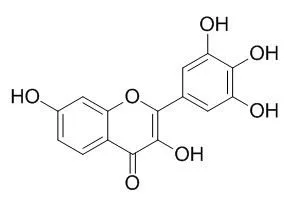| Description: |
Robinetin has antioxidant and antiradical activities, inhibits EYPC membrane lipid peroxidation and HbA glycosylation with high efficiency. Robinetin also has anti-mutagenesis and anti-promotion effects, diminishes ornithine decarboxylase activity induction at 6 h after 12-O-tetradecanoyl phorbol-13-acetate. Robinetin leads to the occurrence of positive induced circular dichroism (ICD) bands in the near ultra-violet (UV) region. |
| Targets: |
HIV |
| In vitro: |
| J Photochem Photobiol B. 2010 Jan 21;98(1):12-9. | | Binding of the bioflavonoid robinetin with model membranes and hemoglobin: Inhibition of lipid peroxidation and protein glycosylation.[Pubmed: 19914085 ] | Recent years have witnessed burgeoning interest in plant flavonoids as novel therapeutic drugs targeting cellular membranes and proteins.
METHODS AND RESULTS:
Motivated by this scenario, we explored the binding of Robinetin (3,7,3',4',5'-pentahydroxyflavone, a bioflavonoid with remarkable 'two color' intrinsic fluorescence properties), with egg yolk phosphatidylcholine (EYPC) liposomes and normal human hemoglobin (HbA), using steady state and time resolved fluorescence spectroscopy. Distinctive fluorescence signatures obtained for Robinetin indicate its partitioning (K(p)=8.65x10(4)) into the hydrophobic core of the membrane lipid bilayer. HbA-Robinetin interaction was examined using both Robinetin fluorescence and flavonoid-induced quenching of the protein tryptophan fluorescence. Specific interaction with HbA was confirmed from three lines of evidence: (a) bimolecular quenching constant K(q)>>diffusion controlled limit; (b) closely matched values of Stern-Volmer quenching constant and binding constant; (c) tau(0)/tau=1 (where tau(0) and tau are the unquenched and quenched tryptophan fluorescence lifetimes, respectively).
CONCLUSIONS:
Absorption spectrophotometric assays reveal that Robinetin inhibits EYPC membrane lipid peroxidation and HbA glycosylation with high efficiency. | | J Mol Model . 2019 Jun 25;25(7):200. | | Theoretical study of the antioxidant capacity of the flavonoids present in the Annona muricata (Soursop) leaves[Pubmed: 31240483] | | Abstract
A theoretical approach was used to evaluate the antioxidant capacity of 20 flavonoids reported in Annona muricata leaves. The theoretical study was at the GGA level using the wB97XD functional and the cc-pvtz basis set. The calculations were performed in gas phase and implicit solvent phase. The flavonol Robinetin (03c) and the flavanol gallocatechin (01c) are species that exhibited the best antioxidant capacity in the HAT, SEPT, and SPLET mechanisms. On the other hand, in the SET I mechanism, flavonol quercetin (03b) was the best, and in the SET II mechanism, the most favored species is the flavanol catechin (01a). However, these species do not achieve to overcome the antioxidant capacity presented by the Trolox.
Keywords: Annona muricata; DFT; Flavonoids; GGA; HAT; SEPT; SET; SPLET; Soursop. |
|
| In vivo: |
| Carcinogenesis. 1986 Jun;7(6):959-63. | | Anti-mutagenesis and anti-promotion by apigenin, robinetin and indole-3-carbinol.[Pubmed: 3708757 ] | We assessed the anti-mutagenic and anti-promotion properties of two flavones, apigenin and Robinetin. Robinetin caused an 87% inhibition of mutagenicity by 2-AA, but indole-3-carbinol had little or no effect on the mutagenicity of any of the compounds.
METHODS AND RESULTS:
Anti-promotion properties were assessed by measuring the effects of apigenin, Robinetin and indole-3-carbinol on induction of ornithine decarboxylase activity (ODC) in mouse epidermis by 17 nmol 12-O-tetradecanoyl phorbol-13-acetate (TPA). Pretreatment of the skin half an hour before TPA with apigenin, Robinetin, butylated hydroxyanisole, 13-cis-retinoic acid (all at 50 mumol) or di-fluoromethylornithine (1.6 mumol) inhibited ODC induction at 6 h after TPA by 67-80%. Pretreatment with 50 mumol indole-3-carbinol caused a 78% elevation in the TPA induction at this time. Dose response measurements were conducted with apigenin, indole-3-carbinol and Robinetin. Inhibition by 30-90% of TPA-induced ODC was observed at 6 h after TPA in mice pretreated with 12.5-100 mumol apigenin. Pretreatment with 37.5 or 50 mumol indole-3-carbinol or 0.5, 12.5 or 25 mumol Robinetin resulted in elevated induction of epidermal ODC by TPA at 6 h after TPA. However, treatment with 50 or 100 mumol Robinetin diminished ODC induction at 6 h after TPA.
Treatment with 100 mumol apigenin or 50 or 100 mumol indole-3-carbinol in non-TPA-treated mouse skin caused elevations in epidermal ODC.
CONCLUSIONS:
In comparing the time course of ODC induction, indole-3-carbinol (50 mumol) pretreatment shifted the induction of epidermal ODC to earlier times, in addition to elevating ODC induction by TPA. |
|






 Cell. 2018 Jan 11;172(1-2):249-261.e12. doi: 10.1016/j.cell.2017.12.019.IF=36.216(2019)
Cell. 2018 Jan 11;172(1-2):249-261.e12. doi: 10.1016/j.cell.2017.12.019.IF=36.216(2019) Cell Metab. 2020 Mar 3;31(3):534-548.e5. doi: 10.1016/j.cmet.2020.01.002.IF=22.415(2019)
Cell Metab. 2020 Mar 3;31(3):534-548.e5. doi: 10.1016/j.cmet.2020.01.002.IF=22.415(2019) Mol Cell. 2017 Nov 16;68(4):673-685.e6. doi: 10.1016/j.molcel.2017.10.022.IF=14.548(2019)
Mol Cell. 2017 Nov 16;68(4):673-685.e6. doi: 10.1016/j.molcel.2017.10.022.IF=14.548(2019)